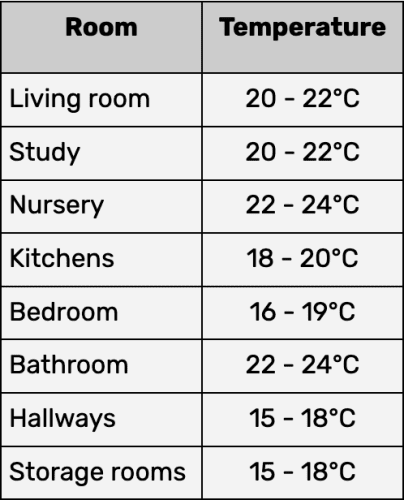The wonders of modern day underfloor heating in your home offers so many benefits that are hard to ignore. With the power to precisely control the heat distribution in each room at specific times of the day, and with the integration with smart controls you can gain so much flexibility. Not only does underfloor heating provide energy-efficient warmth exactly when you need it, but it also offers a direct and comfortable heating experience. That being said, we often get asked for advice on how warm or cold rooms should be set to.
What’s the right temperature for underfloor heating?
Well the obvious answer would be: it depends, right? Some of us are always cold, while others will happily walk around in their shorts during the coldest winters and really it’s a matter of preference. But we can give you advice, based on our years of experience with underfloor heating.
To find the right balance on heating your home you will need to consider a variety of factors such as individual preferences, room usage and how much energy you want to use. Typically we would recommend setting your Underfloor heating manifold to between 35 and 45°C, which should give enough power to heat your rooms up to a maximum of 25 degrees while maintaining efficiency and cost-effectiveness.
If you have room thermostats controlling your system the ideal temperature of a living room should be around 20 to 22°C. This is a room for relaxing in, and where you sit for long periods of time, meaning it should be on the warmer side. Meanwhile, the best temperature for a bathroom or child’s bedroom should a little warmer that that at around 22 to 24°C. For optimal sleep an adult’s bedroom should be between 16°C and 19°C and the ideal room temperature of a kitchen is also between 18°C and 20°C, due to the fluctuation in heat from cooking. We’ve put together this little table below to give you a rough idea.

Temperature with floor types
Not all floor types transfer (or conduct) heat in the same way, different floor materials have varying characteristics that affect their ability to conduct heat efficiently. A dense and solid material like tile or stone conducts heat very well, which allows the effective transfer of heat to the floor surface. These materials can even withstand floor temperatures exceeding 29°C, resulting in a higher heat output. On the other hand, softer flooring options such as wood, laminate, and vinyl have relatively poorer conductivity and many are classed as insulators. Consequently, to avoid damaging delicate floor finishes Wunda recommends using a floor probe that restricts the floor temperature to a maximum of 27°C,
How long does it take underfloor heating to warm up?
The time it takes for underfloor heating to heat up can vary depending on the type of system, flooring material, insulation, and desired temperature increase.
Modern water underfloor heating can heat a room in as little as 30 minutes, comparable to electric UFH and radiators, efficient benefits of water based underfloor heating systems. Typically, traditional screed underfloor heating systems can take between 24 and 48 hours to reach their full operating temperature. Electric systems tend to heat up faster than traditional water-based ones, but are much more expensive to run. You will need to consider room size and insulation quality, as they can affect heating time.
If you want to get the most out of any heating system including underfloor heating, your home should be well insulated. You also may want to switch off your underfloor heating during the summer months. Also, if you happen to have a heat pump, these sometimes have a cooling function, which means you can cool down your home by letting cold water run through the underfloor heating pipes.
Is it ok to leave my underfloor Heating System switched on all day?
We are often asked if it is safe to leave an underfloor heating system switched on all day. The good news is that leaving your underfloor heating on continuously at a reasonable temperature won’t cause any harm to the system. In fact, it can even work out better, especially during colder months. By keeping your underfloor heating system running all day, you can enjoy faster efficiency and quicker warm-up times, ensuring you stay comfortably warm without prolonged periods of feeling chilly.
It’s important to address the misconception surrounding this method, as it is often misunderstood. Leaving a system ‘on’ all day does not mean that the system is pumping warm water around the system constantly. It is more like leaving something on standby, so it will only heat when necessary to achieve the set temperature. To enhance the effectiveness and control of your underfloor heating system, it is recommended to use programmable thermostats or smart home heating controls in conjunction with underfloor heating. Which will allow you to set schedules and temperature adjustments, ensuring optimal comfort and energy efficiency.
More on Smart home heating controls
When it comes to choosing the right thermostat, modern options offer various approaches to control floor temperature. They rely on either air or floor measurements, utilising dedicated probes for accurate readings. Both the thermostat’s precision and the probe’s reliability play a pivotal role in determining the heat output. Additionally, the desired room temperature directly impacts the amount of heat required to achieve optimal comfort.
WundaSmart lets you set the temperature in any room / zone so you control when and where to heat. Not only does this give you superior comfort, but it also reduces energy bills and emissions, so you can do your bit to help the environment.
So whether you have radiators, underfloor heating, or both, control it all in one place – with the WundaSmart app.
If you have any questions – please get in touch
Or if there’s anyone you know who might benefit, please feel free to share!
We’re always happy to help,
View Our Case Studies